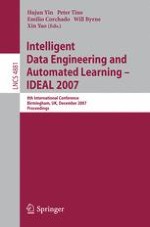2007 | Buch
Intelligent Data Engineering and Automated Learning - IDEAL 2007
8th International Conference, Birmingham, UK, December 16-19, 2007. Proceedings
herausgegeben von: Hujun Yin, Peter Tino, Emilio Corchado, Will Byrne, Xin Yao
Verlag: Springer Berlin Heidelberg
Buchreihe : Lecture Notes in Computer Science
